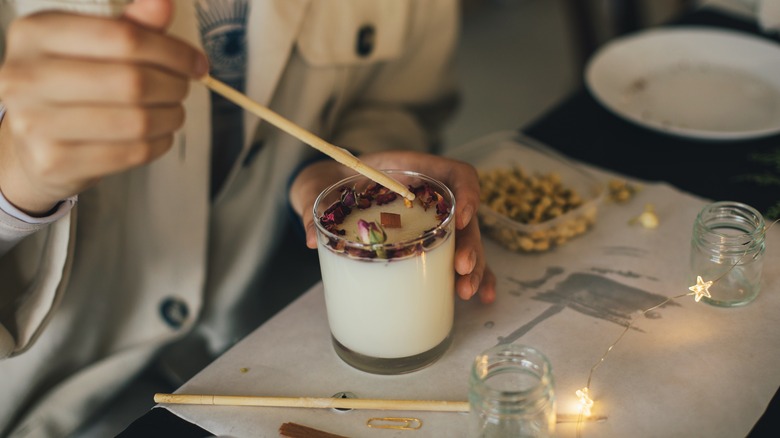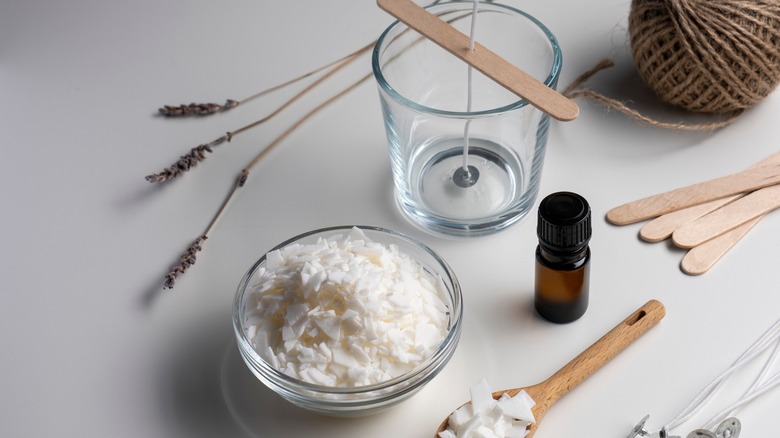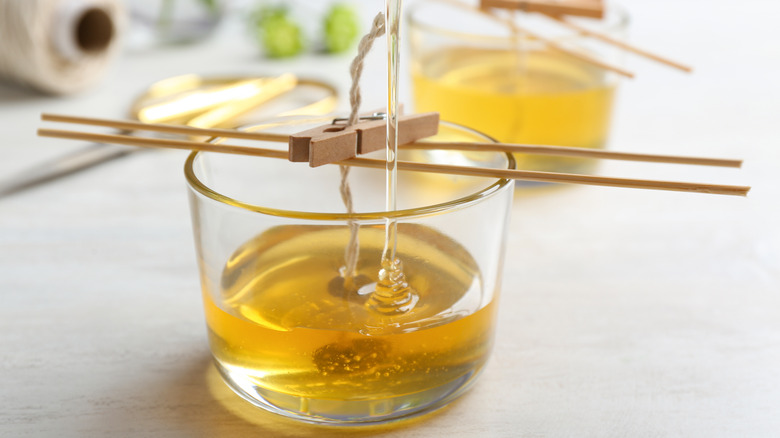What You Need To Know About Making Candles If You're A Beginner
We may receive a commission on purchases made from links.
Nothing beats a cozy evening snuggled on the couch with a warm drink, a good movie, and a flickering candle to set a mellow mood. Scents like cinnamon, apple pie, sandalwood, and amber evoke the warm and fuzzy feelings of fall, while lavender, lilac, and eucalyptus inspire spring blooms. No matter your preferred aroma, candles always seem to offer a little dose of calm and happiness.
But keeping a candle constantly burning can be expensive. Thankfully, both scented and unscented candles are easy and cheap to make. You may already have some of the supplies, like empty containers you can repurpose, but the rest you can buy at your local crafts store or online. To get started, you'll need an old saucepan, heat-resistant pitcher, cooking thermometer, wax, wicks, containers, masking tape or chopsticks, and an optional fragrance, per Apartment Therapy.
So, whether you're searching for the perfect gift for a loved one, looking for a new crafty project, or just plain candle-obsessed, here's everything you need to know about making candles at home.
Find a vessel and place the wick
Choosing the vessels to hold your DIY candles is your chance to be creative. You can repurpose empty candle containers, mason jars, or even tea cups. Thrift stores are also a great resource for finding a set of matching glasses; just make sure the container is heat-safe.
After collecting your materials, the next step is to prep the wick so that it's secured in place and sticking up straight before you pour in the hot wax. Food 52 recommends snipping a hole through masking tape and attaching it to either side of the rim, then running the wick up through the hole. Chopsticks or a popsicle stick will also work.
Standard wicks are made of pre-waxed cotton, but the size wick you use will depend on several factors, such as the type of wax you're using, fragrance composition, and the size and depth of the container, per Northwood Candle Supply. Choosing your wicks is one of the trickiest parts of candle making and may require trial and error, says Food 52. You'll know if the wick is too big if the candle emits smoke and is hard to extinguish, or if it's too small if the melt pool doesn't reach the edge of the candle.
Heat and pour the wax
Paraffin, beeswax, and soy wax are popular waxes used in candle making. According to 100% Pure, beeswax is the oldest and most natural material used for candles. It even acts as an air purifier. Soy wax is a slightly more affordable vegan option that holds scent very well.
To complete the process using soy wax, you'll place your heat-proof pitcher in a pot of boiling water, creating a double broiler. Add 1 pound of wax and slowly melt until it reaches 185 degrees Fahrenheit, stirring frequently. Then add 1 ounce of your fragrance of choice and stir to combine. Once the wax cools to 135 degrees Fahrenheit, you can pour it into your prepared containers. Let the wax cool completely and trim the wick. It may be tempting to light your candle right away, but you should wait a few days, or at least overnight, to let it cure, per Apartment Therapy.
The process of DIY candle-making is simple. However, each type of wax melts at different temperatures, so it's best to read the instructions on the package or manufacturer's website. You can always go unscented, but nothing beats the joy of a seasonal aroma wafting through your home.


